
The meaning and use of the pictograms on
the Phaistos Disk.
The pictures are arranged in 61 sections
of different length and they make up a running story. (The disorderly division into sections may be the work of a helpful child).Each section has
a certain theme. Succeeding sections can be a complement of each other,
e.g. in section 4 it says that the prince, as a landowner, gets power, in
section 5 it says what he brings with him. Within a section the pictograms
can be connected one to another, however, itís not clear if there are rules
for that purpose. In my opinion it is beyond all doubt that pictograms
standing close together have to be combined with each other. See s. 27
3, 4 and 5, s. 33 1 and 2, s. 34 1
and 2, 4 and 5, s. 40 1 and 2, s. 58 2
and 3.
The plural is only mentioned, if it is
important or special. There are more images of their god (s. 3, 9 and 15),
more structures (s. 49) and more years (s. 28). Some-
times it is difficult to decide if a plural
is natural, (birds, oars, arrows), or if it doesnít
matter, (children). In my translation
I always use the singular, unless the plural is essential
for the contents
of the report, e.g. talking about the scarcely dressed, walking man I use
the plural, because I think he represents a group of subjects of a monarch.
On both sides of the disk we frequently
see this man walking, alternated with a boat, hence I suppose we are dealing
here with the story of a journey. In my opinion the author belongs to the
people that took part in it, so the subject of the report must be "we",
(the author and his party). The story ends at the moment the last group,
(in my opinion the author and his party), decides to settle down.
===============
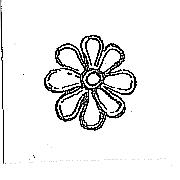 The report starts with the picture of a flower
(s.1). The flower represents the sun and symbolizes the
royal
power. Probably it refers to a certain royal house. The flower
figures also in s. 20 after a shipwreck and in s. 50. I consider the vertical
line on the left side underneath the picture in s. 20 as a possessive pronoun:
"our royal house is still in power, because our prince is alive".
In s. 50 the man walks through the territory the prince took possession
of, that is now in the power of the royal house.
The report starts with the picture of a flower
(s.1). The flower represents the sun and symbolizes the
royal
power. Probably it refers to a certain royal house. The flower
figures also in s. 20 after a shipwreck and in s. 50. I consider the vertical
line on the left side underneath the picture in s. 20 as a possessive pronoun:
"our royal house is still in power, because our prince is alive".
In s. 50 the man walks through the territory the prince took possession
of, that is now in the power of the royal house.
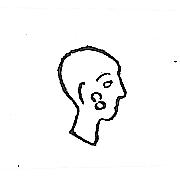 Princes and prelates are represented only
by their heads. It is clear that they donít form part of a group. The little
rings on the cheek indicate that this is a man of royal blood. The
bird with such rings under his right wing is an eagle, the royal bird.
His Highness, in common with the other man, seems to wear a close-fitting
cap. In s. 1 his head is lying backwards, which means that he hadn't yet
come into power. In s. 4 the position of his head is upright, so he is
in power now.
Princes and prelates are represented only
by their heads. It is clear that they donít form part of a group. The little
rings on the cheek indicate that this is a man of royal blood. The
bird with such rings under his right wing is an eagle, the royal bird.
His Highness, in common with the other man, seems to wear a close-fitting
cap. In s. 1 his head is lying backwards, which means that he hadn't yet
come into power. In s. 4 the position of his head is upright, so he is
in power now.
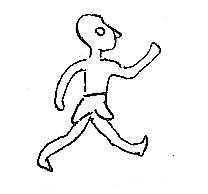 The man walks. He is the one we follow
on his journey. It is obvious that he didnít go all by himself.
He wears a close fitting cap and shorts. He is one of the subjects of a
monarch, thatís why the report begins with the pictograms of the royal
power and person.
The man walks. He is the one we follow
on his journey. It is obvious that he didnít go all by himself.
He wears a close fitting cap and shorts. He is one of the subjects of a
monarch, thatís why the report begins with the pictograms of the royal
power and person.
The man walks through a wood in s. 2,
6, 31, 54 and 55.
He walks through pasture-land in s. 11
and 17. The slant line underneath the picture indicates that there are
two (or more) small groups. See also "the hand".
He takes a walk through the neighbourhood
in s. 21.
He walks through flat land in s. 45.
He walks through water abounding in fish in s. 47
He walks through the territory of the
prince in s. 50.
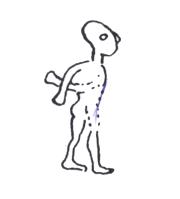 The person (or group) who puts an end to
the protection by the priest. (S. 27). If he keeps his arms crossed
behind his back, it must have a special meaning. I am sure he is not handcuffed.
Handcuffed people are lying face down.
The person (or group) who puts an end to
the protection by the priest. (S. 27). If he keeps his arms crossed
behind his back, it must have a special meaning. I am sure he is not handcuffed.
Handcuffed people are lying face down.
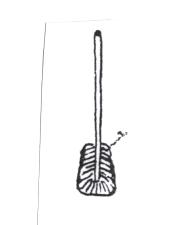 An oar. Considering the length
of the stick it cannot be a feather, nor did I find any prove that it could
be an arrow. (The pictogram of an arrow can be found in s. 48
3)
).
The oar figures in s. 1 and 4 in combination with the prince. In Egyptian hieroglyphics the oar means that a king is going to demarcate the territory of his sovereignty. In the identical sections 12 and 18 the oar is put in front of the boat together with the things
they needed to build a boat.
An oar. Considering the length
of the stick it cannot be a feather, nor did I find any prove that it could
be an arrow. (The pictogram of an arrow can be found in s. 48
3)
).
The oar figures in s. 1 and 4 in combination with the prince. In Egyptian hieroglyphics the oar means that a king is going to demarcate the territory of his sovereignty. In the identical sections 12 and 18 the oar is put in front of the boat together with the things
they needed to build a boat.
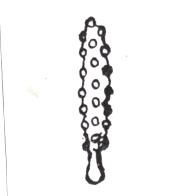 A branch or a kind of tree means a wood
(several trees). Considering the form and thickness it cannot be an arrow
or a spear. In the pictographic script of the Aztecs a similar picture
has the meaning of "club". (Codex Mendoza).
A branch or a kind of tree means a wood
(several trees). Considering the form and thickness it cannot be an arrow
or a spear. In the pictographic script of the Aztecs a similar picture
has the meaning of "club". (Codex Mendoza).
The pictogram for wood is always used
in combination with the walking man. (s. 2, 6, 31, 54 and 55).
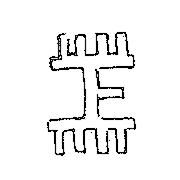 I donít think that this is the plan of a town
or village, because it is open on all sides. Similar pictograms are sometimes
used for proper nouns. Perhaps itís the name of a metal, e.g. bronze
and founded pieces of that metal, such as the heads of hammers, were in
their luggage. It also could be a tool. The sections 3 and 15 are identical
and start with this pictogram.
I donít think that this is the plan of a town
or village, because it is open on all sides. Similar pictograms are sometimes
used for proper nouns. Perhaps itís the name of a metal, e.g. bronze
and founded pieces of that metal, such as the heads of hammers, were in
their luggage. It also could be a tool. The sections 3 and 15 are identical
and start with this pictogram.
 A barbed spear. Probably the flower-like
handle indicates that the spear is made of metal and not of wood. When
they are looking for wood or come across it on the islands, they never
mention the spear among the objects they need the wood for. The spear is
mentioned in the identical sections 3 and 15, in s. 53, when the boat touches
rocky ground and in s. 59 together with a child, a hammer, and a priest.
A barbed spear. Probably the flower-like
handle indicates that the spear is made of metal and not of wood. When
they are looking for wood or come across it on the islands, they never
mention the spear among the objects they need the wood for. The spear is
mentioned in the identical sections 3 and 15, in s. 53, when the boat touches
rocky ground and in s. 59 together with a child, a hammer, and a priest.
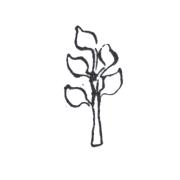 The fire-plant represents the possession
of fire or the possibility to make it. The Aztecs had a more developped
picture for fire that can be seen on their calendar in the years they had
to make fire, that was every 52 years, at the beginning of a new century.
(Codex Mendoza).
The fire-plant represents the possession
of fire or the possibility to make it. The Aztecs had a more developped
picture for fire that can be seen on their calendar in the years they had
to make fire, that was every 52 years, at the beginning of a new century.
(Codex Mendoza).
Sometimes the fire-plant can be combined
with the pictogram that follows, e.g. in s. 22 they bake a fork of clay;
in s. 34 and 46 perhaps the woman knows how to make fire and how to use
it; in s. 49 the fire can be made with flint; in s. 52 the fire can be
in the spring, then it is a hot spring.
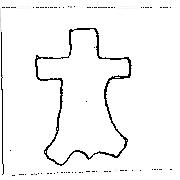 An idol. This broad image with outstretched
arms, found in Crete on several spots, symbolizes the god of the
plains. His task is to provide flat land and smooth water. The idol
is used both for the god and for his work.
An idol. This broad image with outstretched
arms, found in Crete on several spots, symbolizes the god of the
plains. His task is to provide flat land and smooth water. The idol
is used both for the god and for his work.
Only at the beginning of the story the
images are upside down, (s. 3). It means the god is not yet present, because
there is no priest with the power to activate him. In s. 15 the images
are upright. The head of the priest also is in an upright position. In
s. 9 they put between the idols all the objects they needed flat land for;
in s. 12, 18 and 50 the idol is preceded by the pictogram of the boat,
so the water in front of the boat is smooth; in s. 25, 45 and 58 the land
is flat; in s. 26 and 60 the water around the island is smooth; in s. 40
the idol refers to the god of the plains himself, because it is put next
to another idol.
(Some people think that this image is
not an idol, but a kind of bell).
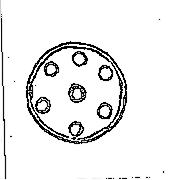 A shield. In this report the shield
is always used in a figurative sense and it means protection. The
same shield, also with seven knobs, can be found in the pictographic script
of the Aztecs. There it has the literal meaning. (Codex Mendoza).
A shield. In this report the shield
is always used in a figurative sense and it means protection. The
same shield, also with seven knobs, can be found in the pictographic script
of the Aztecs. There it has the literal meaning. (Codex Mendoza).
In s. 9, 10, 13, 15, 16, 20, 22, 24, 31
and 61 it is the priest who gives them protection or a sense of security,
in s. 26 it is an island, in s. 30 it is a spring and in s. 57 it is flint.
S. 7 shows in which way the priest protects them. In s. 3 and 27 the priest
is not able to give any protection, because he is without power.
 A priest. From inscriptions in Greek
(linear) script one can deduce that the head
following after (or under) the shield has to be a priest. The priest is
a very important person, he is only represented with his head. Probably
he is a Shaman, because several pictograms on the disk refer to the Shamanism,
such as the "fork" the "saucer" and the object on the prow of the boat.
A priest. From inscriptions in Greek
(linear) script one can deduce that the head
following after (or under) the shield has to be a priest. The priest is
a very important person, he is only represented with his head. Probably
he is a Shaman, because several pictograms on the disk refer to the Shamanism,
such as the "fork" the "saucer" and the object on the prow of the boat.
During the first part of the story the
priest seems indispensable. They need him to indicate the best route, (s.
6, 10, 13, 16, 22/23, 31), and to activate the god, (s. 9, 12, 15, 18).
In section 20 they perhaps inform us that the priest can still protect
them, as he has survived the shipwreck, and in s. 24 that the priest and
the woman work together.
The head of the priest is lying face down
in s. 3, because he is not yet in function, in s. 27, because
they dismissed him as their protector, in s. 34, because the woman pushes
the priest aside. On the coast and on the islands they donít need him anymore.
The group now uses the starry sky as a guide. Besides they found the flat
land they were looking for.
Consequently in the second part of the
story (s. 32 - 61) there is no mention of the priest indicating the route,
(the eagle also has disappeared), but he still seems to help now and then,
(s. 45 and 51). In s. 51 the discovery of a spring is probably due to him.
At the end of the expedition the author once more makes mention of his
presence (s. 59) and when the last group decides to settle down, he again
pictures him in his function of protector. (s. 61).
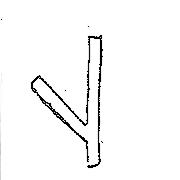 The (tree-)fork is a sacred object
that can be found on a Hittite relief of the world of the gods in front
of the supreme god Shamash.. In my opinion it is a symbol for the accessibility
of the god. This symbol figures only in the first part of the story, when
the god Shamash and his priest are important to the people. There is a
fork in possession of the prince (s. 5) and of the woman (s. 8). In s.
22 they perhaps make a new fork of clay and bake it.
The (tree-)fork is a sacred object
that can be found on a Hittite relief of the world of the gods in front
of the supreme god Shamash.. In my opinion it is a symbol for the accessibility
of the god. This symbol figures only in the first part of the story, when
the god Shamash and his priest are important to the people. There is a
fork in possession of the prince (s. 5) and of the woman (s. 8). In s.
22 they perhaps make a new fork of clay and bake it.
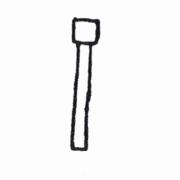 A hammer, to hammer. The hammer
probably has a head of metal, as the prince brought one (or more than one)
with him. Also after the shipwreck they show us the hammer. In s. 59 they
make mention of a hammer together with a spear, a child and a priest. So
it must be an important object. No doubt the handle is made of wood, because
the hammer is pictured every time they find the right wood for it on an
island, (s. 14, 37 and 56).
A hammer, to hammer. The hammer
probably has a head of metal, as the prince brought one (or more than one)
with him. Also after the shipwreck they show us the hammer. In s. 59 they
make mention of a hammer together with a spear, a child and a priest. So
it must be an important object. No doubt the handle is made of wood, because
the hammer is pictured every time they find the right wood for it on an
island, (s. 14, 37 and 56).
They need the hammer to build a boat,
(s. 12 and 18), so it is put in front of the boat together with
the timber and the scull. The structures in s. 30, 37, 49, 52 and 57 have
been made by other people. Only in s. 37 the hammer and the timber are
put after the structure.
Finally the hammer expresses the beating
of the water at the boat in s. 33 and 40. In s. 34 there are two possibilities:
the water beats at the land or there is wood for a hammer on the land.
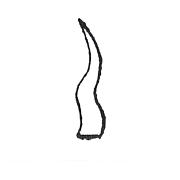 A horn, not a snake. The horn is used
in combination with the eagle to determine the route (s. 7, 10, 13, 16
and 23). In section10, 13 and 16 the line on the right side could be the
shadow of the horn. May be there is a second horn. In s. 51 the priest
perhaps uses the horn as a dowsing-rot and discovers the spring.
A horn, not a snake. The horn is used
in combination with the eagle to determine the route (s. 7, 10, 13, 16
and 23). In section10, 13 and 16 the line on the right side could be the
shadow of the horn. May be there is a second horn. In s. 51 the priest
perhaps uses the horn as a dowsing-rot and discovers the spring.
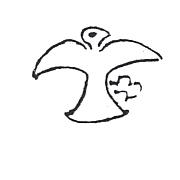 An eagle. The little rings under his
right wing indicate that this is the royal bird, called eagle. To determine
the best route the priest looks at the flight of the eagles. In the inland
that was a very clever way of orientation, because between the mountains
and the trees you could only see part of the sky. Once at the coast there
is no more need to determine the route in that way. Hence in the report
of the 2nd part of the expedition there is no mention of an eagle anymore.
An eagle. The little rings under his
right wing indicate that this is the royal bird, called eagle. To determine
the best route the priest looks at the flight of the eagles. In the inland
that was a very clever way of orientation, because between the mountains
and the trees you could only see part of the sky. Once at the coast there
is no more need to determine the route in that way. Hence in the report
of the 2nd part of the expedition there is no mention of an eagle anymore.
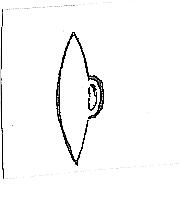 A kind of saucer with a handle is a
sacred object or attribute of a god.This object is in possession of the
woman.
A kind of saucer with a handle is a
sacred object or attribute of a god.This object is in possession of the
woman.
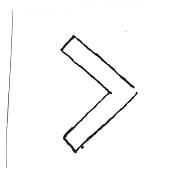 The square is the instrument of the carpenters
and it is their symbol. On the disk it means timber or work of a carpenter. In s. 31 and 54 they perhaps need timber and go to find it or
they use it for a gang-board and go on.
The square is the instrument of the carpenters
and it is their symbol. On the disk it means timber or work of a carpenter. In s. 31 and 54 they perhaps need timber and go to find it or
they use it for a gang-board and go on.
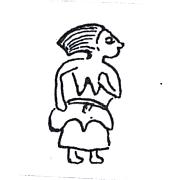 The woman is alone. Although she doesnít
have a high position, she sure is important. She owns property, she brings
with her some sacred objects. Her dress is pictured in detail, she wears
a belt with a pendant. She has timber or she knows about it, (s. 8 and
24). The pendant is perhaps a testimonial of her skill in that field. She
also knows about fire, (s. 34 and 46).
The woman is alone. Although she doesnít
have a high position, she sure is important. She owns property, she brings
with her some sacred objects. Her dress is pictured in detail, she wears
a belt with a pendant. She has timber or she knows about it, (s. 8 and
24). The pendant is perhaps a testimonial of her skill in that field. She
also knows about fire, (s. 34 and 46).
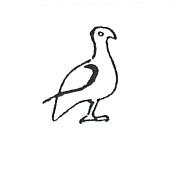 A domesticated bird, poultry,
perhaps a partridge, a guinea-fowl or a goose. In view of his position
with regard to the cages in s. 9 it appears to be a bird that is easy to
domesticate. The bird is eatable, so he is important. He survived the shipwreck
(s. 20). In s. 46 they ones more inform us of the presence of the bird(s)/the
poultry.
A domesticated bird, poultry,
perhaps a partridge, a guinea-fowl or a goose. In view of his position
with regard to the cages in s. 9 it appears to be a bird that is easy to
domesticate. The bird is eatable, so he is important. He survived the shipwreck
(s. 20). In s. 46 they ones more inform us of the presence of the bird(s)/the
poultry.
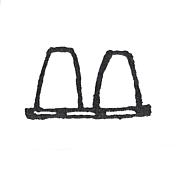 Cages or stables. The pictogram
has to be read horizontally. In s. 9 it is preceded by the bird, in s.
48 by the timber they need to build them.
Cages or stables. The pictogram
has to be read horizontally. In s. 9 it is preceded by the bird, in s.
48 by the timber they need to build them.
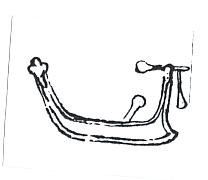 A boat. The boat goes upstream in s.
12, 18, 40 and 50, it goes downstream in s. 33. The object on the prow
of the boat bears a striking resemblance to the one the god Shamash holds
in his hand on a seal from the Akkadian period.
A boat. The boat goes upstream in s.
12, 18, 40 and 50, it goes downstream in s. 33. The object on the prow
of the boat bears a striking resemblance to the one the god Shamash holds
in his hand on a seal from the Akkadian period.
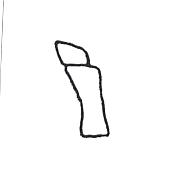 The leg of a cow or bull as a "pars pro toto".
The leg is pictured upside down (s.11 and 17). It means that there is no
cattle, although one could expect it to be present on the spot, because
it is the proper land for cattle, viz. pasture-land.
The leg of a cow or bull as a "pars pro toto".
The leg is pictured upside down (s.11 and 17). It means that there is no
cattle, although one could expect it to be present on the spot, because
it is the proper land for cattle, viz. pasture-land.
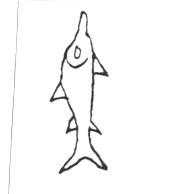 Fish. It always means that there is
fish. (s. 14, 27, 47, 55 and 57). On Hittite reliefís sometimes a fish
is pictured upside down.
Fish. It always means that there is
fish. (s. 14, 27, 47, 55 and 57). On Hittite reliefís sometimes a fish
is pictured upside down.
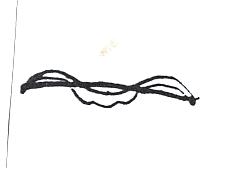 In all probability it means a shipwreck.
This pictogram has to be read horizontally and figures only in s. 19 in
combination with the symbol of the god of the weather.
In all probability it means a shipwreck.
This pictogram has to be read horizontally and figures only in s. 19 in
combination with the symbol of the god of the weather.
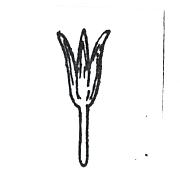 The lightning-flower symbolizes the god
of the weather. He causes the shipwreck (s. 19) and provides fish (s.
46 and 55) and timber (s. 35).
The lightning-flower symbolizes the god
of the weather. He causes the shipwreck (s. 19) and provides fish (s.
46 and 55) and timber (s. 35).
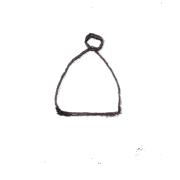 (Flat) land. I deduced the meaning
of this pictogram, a kind of triangle in the shape of a womanís breast
with a globule on top, from the Egyptian pictogram for cattle, the same
kind of triangle with two little horns ( \/ ) on top.
The picture for land is used in combination with the picture for water,
when they mean an island (s. 26, 29, 32, 38, 42 and 60). In s. 29,
32, 38 and 42 there is a vertical line in the middle underneath the pictogram
for land. I think they indicate in this way that they are on an
island. In s. 29 they are for the first time on an island.
(Flat) land. I deduced the meaning
of this pictogram, a kind of triangle in the shape of a womanís breast
with a globule on top, from the Egyptian pictogram for cattle, the same
kind of triangle with two little horns ( \/ ) on top.
The picture for land is used in combination with the picture for water,
when they mean an island (s. 26, 29, 32, 38, 42 and 60). In s. 29,
32, 38 and 42 there is a vertical line in the middle underneath the pictogram
for land. I think they indicate in this way that they are on an
island. In s. 29 they are for the first time on an island.
 Water, probably the sea, as this sign
is never used in combination with a fish.
Water, probably the sea, as this sign
is never used in combination with a fish.
 A spring. This picture seems to have
something to do with water. The form is suggestive of a spring. A spring
figures in s. 21, 27, 30, 51, 52 and 61.
A spring. This picture seems to have
something to do with water. The form is suggestive of a spring. A spring
figures in s. 21, 27, 30, 51, 52 and 61.
In s. 52 it is possible to combine the
spring with the pictogram for fire, then it is a hot spring.
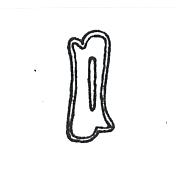 Clay. Also this picture seems to have
something to do with water. Its place, next to a spring (s. 21), leads
to the conclusion that it is clay. In s. 22 the pictogram for clay is preceded
by a fork, probably the fork is made of clay.
Clay. Also this picture seems to have
something to do with water. Its place, next to a spring (s. 21), leads
to the conclusion that it is clay. In s. 22 the pictogram for clay is preceded
by a fork, probably the fork is made of clay.
H.TH. Bossert thinks that it is a bar
of metal. In that case the preceding pictogram in s. 21 is not likely to
be a spring.
 Taking possession of, after a fight
(may be among themselves). The closed hand is wrapped up in a fighting-band.
In s. 25, 36, 41 and 44 they take possession of land. The slant line underneath
the hand, on the right side in s. 36 and on the left side in s. 41, probably
means that there are different groups.
Taking possession of, after a fight
(may be among themselves). The closed hand is wrapped up in a fighting-band.
In s. 25, 36, 41 and 44 they take possession of land. The slant line underneath
the hand, on the right side in s. 36 and on the left side in s. 41, probably
means that there are different groups.
 Unclear pictogram. As it is put between the
pictogram for "taking possession of" and the pictogram for "everything
that is flat" I assume that they picture a certain kind of land. In my
opinion it is a peninsula, of which the form is indicated.
Unclear pictogram. As it is put between the
pictogram for "taking possession of" and the pictogram for "everything
that is flat" I assume that they picture a certain kind of land. In my
opinion it is a peninsula, of which the form is indicated.
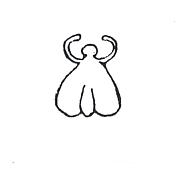 An idol. From
the posture, a little figure with two arms bent in a circular shape and
pointing towards the sky, - in the Egyptian hieroglyphics
a man pointing upwards means that something is situated
high up - I understand that this is the god of the starry sky, the
firmament. In s. 28 and 33 this idol precedes
the constellation of stars "Canis"(?); in s. 40 it precedes the image of
the god of the flat land.
An idol. From
the posture, a little figure with two arms bent in a circular shape and
pointing towards the sky, - in the Egyptian hieroglyphics
a man pointing upwards means that something is situated
high up - I understand that this is the god of the starry sky, the
firmament. In s. 28 and 33 this idol precedes
the constellation of stars "Canis"(?); in s. 40 it precedes the image of
the god of the flat land.
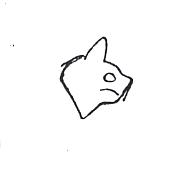 A constellation of stars. The picture
is small and returns in the continuation of the story in different positions.
(s. 28, 29, 33, 36, 41, 42, 43, 44, 47 and 49). I think it is meant to
represent a dog, so we are dealing here with the constellation "Canis".
In s. 28 this pictogram is shown two times, which means that some years
have passed.
A constellation of stars. The picture
is small and returns in the continuation of the story in different positions.
(s. 28, 29, 33, 36, 41, 42, 43, 44, 47 and 49). I think it is meant to
represent a dog, so we are dealing here with the constellation "Canis".
In s. 28 this pictogram is shown two times, which means that some years
have passed.
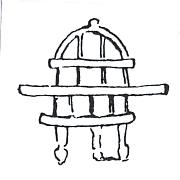 A structure on three piles. It seems
to be closed on one side. Probably it is a pigeon-house used for carrier-pigeons.
In the Mesopotamian glyptic from 3000-2000 B.C. we only see rectangular
houses of two floors with dome-shaped roofs. It is obvious that they didnít
build a house of 3 floors on 3 piles. The structure is mentioned in s.
30, 37, 49, 52 and 57.
A structure on three piles. It seems
to be closed on one side. Probably it is a pigeon-house used for carrier-pigeons.
In the Mesopotamian glyptic from 3000-2000 B.C. we only see rectangular
houses of two floors with dome-shaped roofs. It is obvious that they didnít
build a house of 3 floors on 3 piles. The structure is mentioned in s.
30, 37, 49, 52 and 57.
 The god of fertility or vegetation
is represented by the head of a ram, like the Egyptian god Chnoem. (An
image from the Akkadian (?) period shows the sun-god with a ram at his
side). This pictogram only figures in s. 35.
The god of fertility or vegetation
is represented by the head of a ram, like the Egyptian god Chnoem. (An
image from the Akkadian (?) period shows the sun-god with a ram at his
side). This pictogram only figures in s. 35.
 A pictogram difficult to explain. From the
context one could conclude that it is a symbol for fertility. In
s. 35 it follows after the god of fertility, in s. 45 it precedes the picture
of the priest.
A pictogram difficult to explain. From the
context one could conclude that it is a symbol for fertility. In
s. 35 it follows after the god of fertility, in s. 45 it precedes the picture
of the priest.
 A bush in the shape of a fork is the pictogram
for inaccessibility, as the fork of a tree expresses the accessibility
in relation to the supreme god. When they take possession of land this
fork follows after the picture for land, so the land is inaccessible (s.
36, 41 and 44). In s. 51 the spring is inaccessible.
A bush in the shape of a fork is the pictogram
for inaccessibility, as the fork of a tree expresses the accessibility
in relation to the supreme god. When they take possession of land this
fork follows after the picture for land, so the land is inaccessible (s.
36, 41 and 44). In s. 51 the spring is inaccessible.
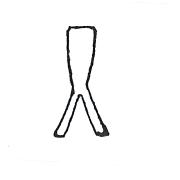 The seat is used for to settle down.
In s. 36 and 41 they show us the position of the constellation of stars
at the moment they settle down; in s. 53 they decide to settle down because
it is difficult to keep the boat floating; in s. 61 they choose a spot
next to a spring to settle down and in s. 58 they put the boat(s) ashore.
The seat is used for to settle down.
In s. 36 and 41 they show us the position of the constellation of stars
at the moment they settle down; in s. 53 they decide to settle down because
it is difficult to keep the boat floating; in s. 61 they choose a spot
next to a spring to settle down and in s. 58 they put the boat(s) ashore.
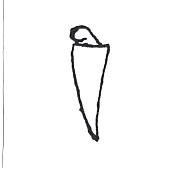 An arrow. These knife-like arrows were
shot with a special bow. Its position with the point downwards indicates
that they are using them. (Compare the position of flint). The arrow is
mentioned in s. 48 and 56, when they find the different kinds of wood that
can be used for certain objects.
An arrow. These knife-like arrows were
shot with a special bow. Its position with the point downwards indicates
that they are using them. (Compare the position of flint). The arrow is
mentioned in s. 48 and 56, when they find the different kinds of wood that
can be used for certain objects.
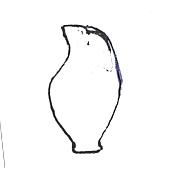 Flint. On the calendar of the Aztecs
one out of every four years is indicated by the pictogram for flint. The
same pictogram figures on the disk in s. 49 and 57. With the point downwards
it is a knife of flint. Here they still donít use knives of flint.
Flint. On the calendar of the Aztecs
one out of every four years is indicated by the pictogram for flint. The
same pictogram figures on the disk in s. 49 and 57. With the point downwards
it is a knife of flint. Here they still donít use knives of flint.
According to A.J. Evans it is not the
picture of flint (a knife upside down), but of a water-jug. He says he
originally saw a kind of handle, that later on has been brushed off. As
it is not possible to brush off baked clay, I suppose there was a bit of
earth caked.
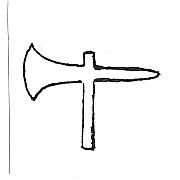 Something that is made by a pickaxe, a
cleft. The helve points in the wrong direction. It should be on the
other side, so that the man, approaching, could catch the helve. The position
pictured on the disk indicates the result of its use. As the pictogram
for land precedes, it here concerns a cleft in the land. This pictogram
figures only in
Something that is made by a pickaxe, a
cleft. The helve points in the wrong direction. It should be on the
other side, so that the man, approaching, could catch the helve. The position
pictured on the disk indicates the result of its use. As the pictogram
for land precedes, it here concerns a cleft in the land. This pictogram
figures only in
s. 54.
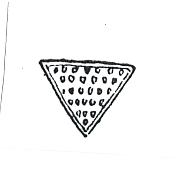 With an amount of dots the Aztecs indicate
that there is sandy soil. The triangle can indicate danger and serve
as a warning. We still use the triangle as a traffic sign for caution.
Perhaps there is quicksand or a swamp. This pictogram figures only in s.
56.
With an amount of dots the Aztecs indicate
that there is sandy soil. The triangle can indicate danger and serve
as a warning. We still use the triangle as a traffic sign for caution.
Perhaps there is quicksand or a swamp. This pictogram figures only in s.
56.
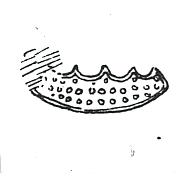 Rocky sea bottom. Here also the soil
is sandy, but at the same time itís very rocky, so that the boat runs aground.
This pictogram figures only in s. 53.
Rocky sea bottom. Here also the soil
is sandy, but at the same time itís very rocky, so that the boat runs aground.
This pictogram figures only in s. 53.
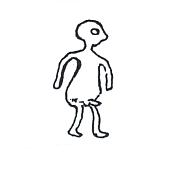 A male child. The posture of this little
figure reminds a child. Besides it wears an apron or a skirt and can hardly
walk. The slant line on the left side is perhaps the personal pronoun of
the 1st person. This pictogram figures only in s. 59.
N.B. Some pictures have to be read horizontally in the reading direction, they are in a vertical position to
save room.
A male child. The posture of this little
figure reminds a child. Besides it wears an apron or a skirt and can hardly
walk. The slant line on the left side is perhaps the personal pronoun of
the 1st person. This pictogram figures only in s. 59.
N.B. Some pictures have to be read horizontally in the reading direction, they are in a vertical position to
save room.
Consulted books.
Hedwig Roolvink.
